Our Services
Contact Us
Climax Adventure Pvt. Ltd.
New Baneshor ( Minbhawan,34) Kathmandu, Nepal
Phone: +977 9841875014, 9741070619
Email: [email protected]
[email protected]
Website: www.climaxadventure.com
Festival in Nepal
The Climax Adventure is organized the festivals tour and treks. Join with us for following festivals tour.
The Macchindra Jatra
 This historically significant festival celebrates Machchhindra, the guardian deity of Nepal. Ceremonies commences on the 1st of Baisakh, when the idol is bathed in holy water in the Bagmati. It is then taken to Patan, mounted on a large rath or car and a shrine is placed with carvings and flowers. The whole procession may take up to a week and the idol of Machchhindra is displayed in Patan for a month, before taken back to the Bagmati and placed back in its home temple in Kathmandu. The day that it is returned is referred to as Gudrijhar and the blanket of the idol is symbolically shaken to reveal its emptiness to represent contentment, despite poverty. Although it use to be celebrate one time a year, but every 12 years main celebrations has been celebrated.
This historically significant festival celebrates Machchhindra, the guardian deity of Nepal. Ceremonies commences on the 1st of Baisakh, when the idol is bathed in holy water in the Bagmati. It is then taken to Patan, mounted on a large rath or car and a shrine is placed with carvings and flowers. The whole procession may take up to a week and the idol of Machchhindra is displayed in Patan for a month, before taken back to the Bagmati and placed back in its home temple in Kathmandu. The day that it is returned is referred to as Gudrijhar and the blanket of the idol is symbolically shaken to reveal its emptiness to represent contentment, despite poverty. Although it use to be celebrate one time a year, but every 12 years main celebrations has been celebrated.
Bajra Jogini Jatra
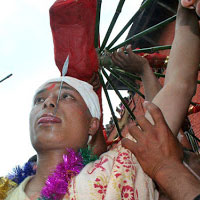 Bajra Jogini was originally celebrated by Buddhists but is also celebrated by Hindus on the 3rd of Baisakh. Her temple, Kharg Jogini, is found at Manichur mountain, near Sankhu. During the long festival, a fire is burned in the vicinity of the temple near an image of a human head. An image of the goddess is placed in a khat (a wooden shrine) and carried through the town by the men.
Bajra Jogini was originally celebrated by Buddhists but is also celebrated by Hindus on the 3rd of Baisakh. Her temple, Kharg Jogini, is found at Manichur mountain, near Sankhu. During the long festival, a fire is burned in the vicinity of the temple near an image of a human head. An image of the goddess is placed in a khat (a wooden shrine) and carried through the town by the men.
Siti Jatra
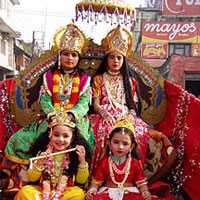 The Siti Jatra takes place on the 21st of Jeth, on the banks of the Vishnumati, between Kathmandu and Simbhunath. The people feast and afterwards divide into two teams to contest a stone throwing competition. The match was once a serious affair and anybody who was knocked down or captured by the other party was sacrificed to the goddess Kankeshwari. In modern times, however. it is a light hearted affair, mostly among the children.
The Siti Jatra takes place on the 21st of Jeth, on the banks of the Vishnumati, between Kathmandu and Simbhunath. The people feast and afterwards divide into two teams to contest a stone throwing competition. The match was once a serious affair and anybody who was knocked down or captured by the other party was sacrificed to the goddess Kankeshwari. In modern times, however. it is a light hearted affair, mostly among the children.
Gauthier Mangal or Ghanta Karn
 This festival refers to the celebration of the expulsion of a Rakshasa or demon from the country, held on the 14th of Sawan. The Newars make a straw figure which they beat and drag around the streets. The figures are burned at sunset.
This festival refers to the celebration of the expulsion of a Rakshasa or demon from the country, held on the 14th of Sawan. The Newars make a straw figure which they beat and drag around the streets. The figures are burned at sunset.
Banra Jatra
 The festival is celebrated twice a year, on the 8th of Sawan and the 13th of Bhadon. The Banras, priests of the Newar Buddhists visit each house and receive a small offering of grain or rice to commemorate their ancestors who were not permitted to trade. The Newars decorate their shops and houses with pictures and flowers and the women sit with large baskets of rice and grain to dispense to the Banras.
The festival is celebrated twice a year, on the 8th of Sawan and the 13th of Bhadon. The Banras, priests of the Newar Buddhists visit each house and receive a small offering of grain or rice to commemorate their ancestors who were not permitted to trade. The Newars decorate their shops and houses with pictures and flowers and the women sit with large baskets of rice and grain to dispense to the Banras.
Janai Purnima
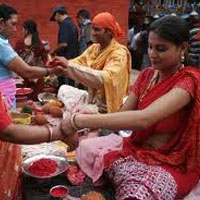 The Rakhi Purnima festival takes place on the last day of Sawan and is celebrated by both Buddhists and Hindus. However the Buddhist bathe in sacred streams and visit their temples and the Brahman priests tie an ornamental thread to the wrists of their followers and in return receive gifts. Many pilgrims visit Gosain Than and bathe at the sacred lake.
The Rakhi Purnima festival takes place on the last day of Sawan and is celebrated by both Buddhists and Hindus. However the Buddhist bathe in sacred streams and visit their temples and the Brahman priests tie an ornamental thread to the wrists of their followers and in return receive gifts. Many pilgrims visit Gosain Than and bathe at the sacred lake.
Nag Panchami
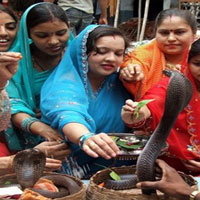 Nag Panchani takes place on the 5th of Sawan to commemorate the battle between Nag and Garur. The stone image of Garur at Changu Narayan is said to perspire during the festival and priests are sent to wipe the perspiration off with a handkerchief. They later present it to the king and water is used to make it into a snake bite remedy, despite the fact that there are few snakes inhabiting Nepal.
Nag Panchani takes place on the 5th of Sawan to commemorate the battle between Nag and Garur. The stone image of Garur at Changu Narayan is said to perspire during the festival and priests are sent to wipe the perspiration off with a handkerchief. They later present it to the king and water is used to make it into a snake bite remedy, despite the fact that there are few snakes inhabiting Nepal.
Janmashtami
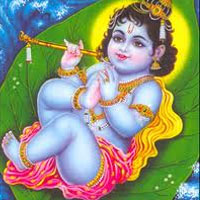 Janmashtami is celebrated on the 8th of Bhadon, in memory of Krishna. Shops and houses are adorned in celebration.
Janmashtami is celebrated on the 8th of Bhadon, in memory of Krishna. Shops and houses are adorned in celebration.
Gai Jatra
 This entirely Newar festival is held on the 1st day of Bhadon. Newars who have lost loved ones during the year traditionally disguised themselves as cows and danced around the palace of the king. However, in modern times, the ceremony is performed only as a masked dance with the singing of songs.
This entirely Newar festival is held on the 1st day of Bhadon. Newars who have lost loved ones during the year traditionally disguised themselves as cows and danced around the palace of the king. However, in modern times, the ceremony is performed only as a masked dance with the singing of songs.
Bagh Jatra
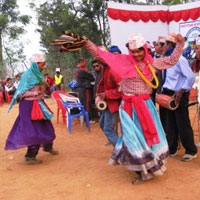 This festival takes place on the 2nd of Bhadon. Dancers once dressed up in tiger costumes but today it is merely a repetition of the Gai Jatra festival.
This festival takes place on the 2nd of Bhadon. Dancers once dressed up in tiger costumes but today it is merely a repetition of the Gai Jatra festival.
Indra Jatra
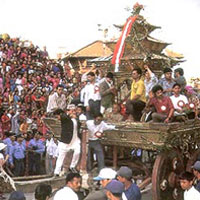 The Indra Jatra festival begins on the 26th of Bhadon and lasts for eight days. On the first day a lofty wooden post is erected before the king's palace and dancers from all across Nepal perform with masks. If an earthquake ever occurred on the opening day of the festival this was considered a bad omen and the festival would have to be restarted. On the third day, young virgins are brought before the king and worshipped and then carried through Kathmandu, mounted on oars.
The Indra Jatra festival begins on the 26th of Bhadon and lasts for eight days. On the first day a lofty wooden post is erected before the king's palace and dancers from all across Nepal perform with masks. If an earthquake ever occurred on the opening day of the festival this was considered a bad omen and the festival would have to be restarted. On the third day, young virgins are brought before the king and worshipped and then carried through Kathmandu, mounted on oars.
Dashain
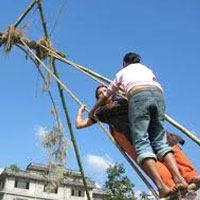 This festival takes place on the 26th of Kuar. It lasts for 10 days and buffaloes and goats are sacrificed. On the initial festival day, the Brahmans sow barley at the place where they worship and ritualistically sprinkle it with sacred water on a daily basis. On the tenth day they pull it up and present it in bunches to their followers.
This festival takes place on the 26th of Kuar. It lasts for 10 days and buffaloes and goats are sacrificed. On the initial festival day, the Brahmans sow barley at the place where they worship and ritualistically sprinkle it with sacred water on a daily basis. On the tenth day they pull it up and present it in bunches to their followers.
Deepawali
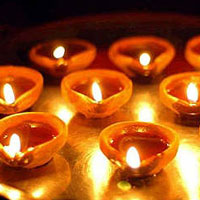 Deepawali takes place on the 15th of Kartik as part of the Tihar Festival to worship Lakshmi, the goddess of wealth. People illuminate their houses and gambling is permitted for three days and nights. During the celebrations gamblers are found in the streets and some gamblers are known to make extreme bets such as staking their own wives and even their own hands.
Deepawali takes place on the 15th of Kartik as part of the Tihar Festival to worship Lakshmi, the goddess of wealth. People illuminate their houses and gambling is permitted for three days and nights. During the celebrations gamblers are found in the streets and some gamblers are known to make extreme bets such as staking their own wives and even their own hands.
Khicha Puja or Gai Puja/Sa Paru
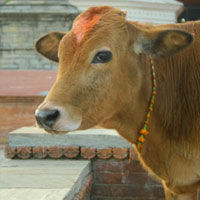 Khicha Puja is a Newar festival held on the 15th of Kartik in late autumn as part of the Tihar Festival. Dog, crows and cows are especially prominent during this festival and dogs are commonly seen with wreaths of flowers around their necks. Crows are worshipped by offerings of sweets and dishes. The cawing of the crows symbolises sadness and grief in the Hindu mythology, so the devotees offer the crows food to avert grief and deaths in their homes. Cows are commonly celebrated on the third day of Tihar, as they are regarded as the mothers of the universe in Hinduism, where after weaning by the birth mother, the cow acts as the surrogate mother to humans, providing milk for the rest of the human life. A tika is placed on the forehead of the cow and a flower garland is placed on the neck. The cow festival is known as Gai Puja in Nepali but commonly referred to as Sa Paru.
Khicha Puja is a Newar festival held on the 15th of Kartik in late autumn as part of the Tihar Festival. Dog, crows and cows are especially prominent during this festival and dogs are commonly seen with wreaths of flowers around their necks. Crows are worshipped by offerings of sweets and dishes. The cawing of the crows symbolises sadness and grief in the Hindu mythology, so the devotees offer the crows food to avert grief and deaths in their homes. Cows are commonly celebrated on the third day of Tihar, as they are regarded as the mothers of the universe in Hinduism, where after weaning by the birth mother, the cow acts as the surrogate mother to humans, providing milk for the rest of the human life. A tika is placed on the forehead of the cow and a flower garland is placed on the neck. The cow festival is known as Gai Puja in Nepali but commonly referred to as Sa Paru.
Bhai Tika
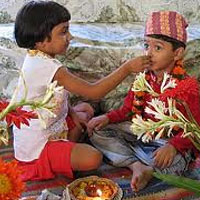 On the 17th of Kartik, as part of the Tihar Festival, women visit the house of their brother's, and place a tika or mark on his forehead and a garland around his neck. The sister then bathes his feet and gives him sweetmeats to eat. In return she receives a gift of money, clothes or ornaments.
On the 17th of Kartik, as part of the Tihar Festival, women visit the house of their brother's, and place a tika or mark on his forehead and a garland around his neck. The sister then bathes his feet and gives him sweetmeats to eat. In return she receives a gift of money, clothes or ornaments.
Bala Chaturdasi or Satbyu
 This festival takes places on the 14th of Aghan, when people gather in the forest of Mrigasthali near the temple of Pashupati to scatter an offering of rice, vegetables and sweetmeats.
This festival takes places on the 14th of Aghan, when people gather in the forest of Mrigasthali near the temple of Pashupati to scatter an offering of rice, vegetables and sweetmeats.
Kartik Purnima
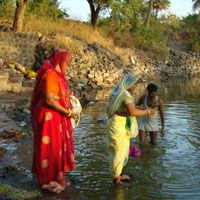 Main article: Kartik Poornima
Main article: Kartik Poornima
On the first day of the month of Kartik, many women go to the temple of Pashupati. There they remain for an entire month, fasting and drinking only water. Some women have died during the fasting but the majority generally survives and on the last day of the month, known as the purnima, the night is spent rejoicing the success of the fasting by singing and dancing into the night.
Ganesh Chauth
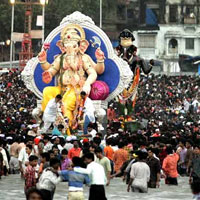 The Ganesh Chauth festival is held on the 4th of Magh, in honor of Ganesh, the god of wisdom. The day is spent fasting and worshipping and in ended by feasting into the night.
The Ganesh Chauth festival is held on the 4th of Magh, in honor of Ganesh, the god of wisdom. The day is spent fasting and worshipping and in ended by feasting into the night.
Maghe Sankranti
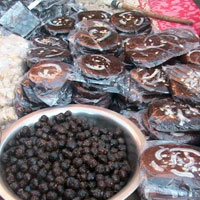 Maghe sankranti is observed in the month of January on the first day of the month of Magh, bringing an end to the ill-omened month of Poush when all religious ceremonies are forbidden. On this day, the sun leaves its southernmost position and takes off for its northward journey, so Maghe Sankranti is similar to solstice festivals in many other traditions. People participate in holy bathing in this festival and auspicious foods like laddoo, ghee, sweet potatoes etc. are distributed. The mother of the house wishes good health to all family members. According to Mahabharata, king Bhisma, who had the power to control his own death, happened to choose to die on the day of Maghe Sakranti. Therefore it is believed that to die on this day might achieve Moksha, a release from the rebirth cycle.
Maghe sankranti is observed in the month of January on the first day of the month of Magh, bringing an end to the ill-omened month of Poush when all religious ceremonies are forbidden. On this day, the sun leaves its southernmost position and takes off for its northward journey, so Maghe Sankranti is similar to solstice festivals in many other traditions. People participate in holy bathing in this festival and auspicious foods like laddoo, ghee, sweet potatoes etc. are distributed. The mother of the house wishes good health to all family members. According to Mahabharata, king Bhisma, who had the power to control his own death, happened to choose to die on the day of Maghe Sakranti. Therefore it is believed that to die on this day might achieve Moksha, a release from the rebirth cycle.
Basant or Sripanchami
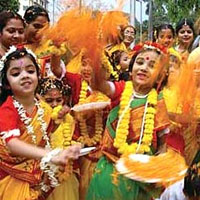 This festival takes place on the 20th of Magh in the honor of Saraswati, the goddess of learning.
This festival takes place on the 20th of Magh in the honor of Saraswati, the goddess of learning.
Holi
 The festival takes place on the last day of Phagun. In Nepal, a wooden post, known as a chir is adorned with flags and erected in front of the palace. It is burned at night, representing the burning of the body of the old year.
The festival takes place on the last day of Phagun. In Nepal, a wooden post, known as a chir is adorned with flags and erected in front of the palace. It is burned at night, representing the burning of the body of the old year.
Maghi Purnima
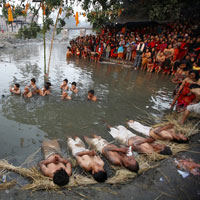 The bathing festival where Newars bathe in the Bagmati River. during Magh. On the last day of the month, bathers are carried in a procession in ornamented dolis, lying on their backs with lighted lamps (known as chirags) on their chests, arms and legs. Other bathers bear earthen water pots on their heads, perforated with straws, through which water seeps down to sprinkle passers by. Traditionally the bathers wear green spectacles to protect their eyes from the sparks of the lamps they are in contact with.
The bathing festival where Newars bathe in the Bagmati River. during Magh. On the last day of the month, bathers are carried in a procession in ornamented dolis, lying on their backs with lighted lamps (known as chirags) on their chests, arms and legs. Other bathers bear earthen water pots on their heads, perforated with straws, through which water seeps down to sprinkle passers by. Traditionally the bathers wear green spectacles to protect their eyes from the sparks of the lamps they are in contact with.
Ghode Jatra
 Traditionally on the 15th of Chait, all horses and ponies belonging to government servants were assembled at the grand parade ground and entered into a race in front of the king and top officials who are stationed around a central monument. The monument bore Sir Jang Bahadur's statue. After the event, gambling is allowed for two days and nights and the festival ends with an illumination of the monument. In 1875, Bahadur's statue and four dragon monuments were moved into a newly built temple in his honor, hence the location of the festival moved.
Traditionally on the 15th of Chait, all horses and ponies belonging to government servants were assembled at the grand parade ground and entered into a race in front of the king and top officials who are stationed around a central monument. The monument bore Sir Jang Bahadur's statue. After the event, gambling is allowed for two days and nights and the festival ends with an illumination of the monument. In 1875, Bahadur's statue and four dragon monuments were moved into a newly built temple in his honor, hence the location of the festival moved.

